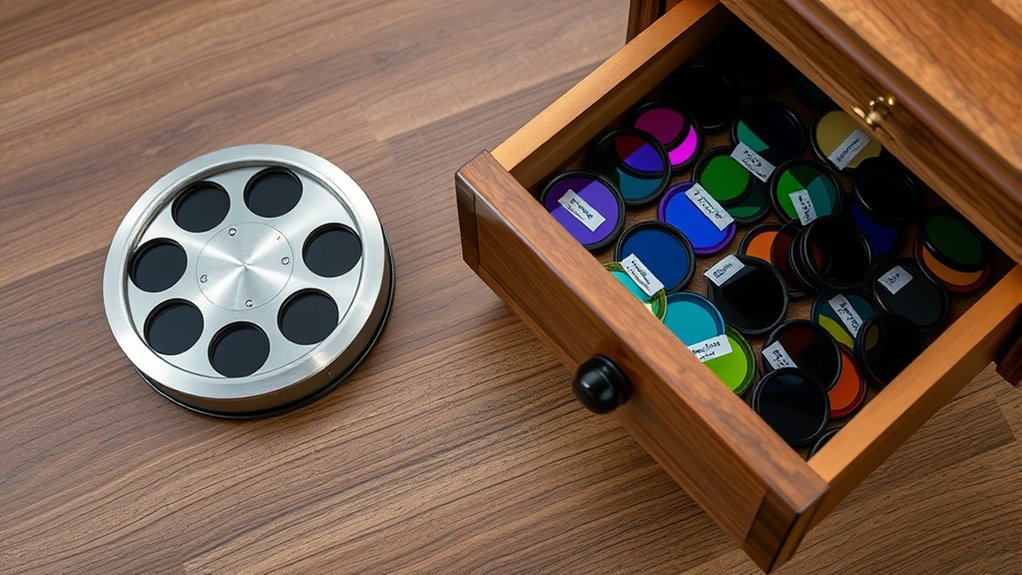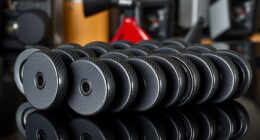Before choosing between filter wheels and drawers, consider automation needs, compatibility with your telescope and camera, and ease of use. Filter wheels offer quick, remote-controlled changes and are more durable, but tend to be more expensive. Drawers are more affordable and simple to operate manually, though less suited for automation or outdoor environments. Evaluating these factors helps make certain your setup matches your budget and future goals—keep going to explore each option in detail.
Key Takeaways
- Assess automation compatibility to ensure quick filter changes and software integration.
- Verify compatibility with your telescope or camera system, including mounting and filter sizes.
- Consider ease of use: motorized wheels vs manual drawers, based on your frequency of filter swaps.
- Evaluate durability and maintenance needs according to your operating environment.
- Factor in budget, long-term costs, and potential for future expansion or upgrades.
Key Factors to Consider When Choosing Filter Wheels or Drawers

Choosing between filter wheels and drawers can considerably impact your optical system’s efficiency and ease of use. Before making that decision, you need to evaluate several factors that could influence your setup‘s performance. One of the most critical aspects is automation considerations. If you plan to automate your imaging process, you’ll want a system that integrates smoothly with your existing automation tools. Filter wheels often offer better compatibility with remote control software, allowing you to switch filters quickly without manual intervention. Drawers, on the other hand, may require additional hardware or custom integration to achieve the same level of automation, which can complicate setup and increase costs. Additionally, the design of the filter mechanism can influence the speed and reliability of filter changes, impacting your overall workflow efficiency.
Compatibility issues are another essential factor to consider. Not all filter wheels or drawers are universally compatible with every telescope or camera system. You must verify that the mounting adapters, connection interfaces, and filter sizes match your equipment specifications. For example, some filter wheels support only specific filter diameters or connector types, which could limit your choices or necessitate additional adapters. Drawers tend to be more versatile in accommodating different filter sizes, but they may lack the precision or locking mechanisms needed for secure, repeatable filter positions. Ensuring compatibility from the start helps prevent delays or the need for costly modifications later on.
Verify compatibility of filter sizes and connection interfaces to avoid delays and costly modifications.
Ease of use also plays a significant role. Filter wheels are generally more straightforward to operate, especially if they are motorized and controlled via software. They allow for quick, seamless filter changes during imaging sessions, saving you time and reducing frustration. Drawers often require manual insertion and removal of filters, which can be cumbersome and increase the risk of misalignment or damage. Consider how often you’ll need to swap filters and whether the convenience of automation outweighs the simplicity of manual drawers.
Durability and maintenance are additional aspects to weigh. Filter wheels tend to be more robust, with fewer moving parts exposed to dust and debris. They often come with sealed mechanisms that protect against environmental factors, making them suitable for outdoor or rugged conditions. Drawers, especially those with manual operation, may be more vulnerable to mechanical wear or dirt ingress, requiring regular cleaning or repairs. Think about your operating environment and how much maintenance you’re willing to undertake.
Finally, budget constraints and future expansion plans should influence your choice. Filter wheels can be more expensive upfront but might offer better long-term efficiency and versatility, especially if you’re automating your workflow. Drawers are usually more affordable initially but may incur extra costs if you need to upgrade or replace parts down the line. By carefully considering automation considerations, compatibility issues, ease of use, durability, and cost, you can make an informed decision that best suits your specific needs and enhances your imaging experience.
Frequently Asked Questions
What Is the Typical Lifespan of Filter Wheels and Drawers?
Filter wheel durability typically ranges from 5 to 10 years, depending on usage and maintenance, while drawer longevity can span 3 to 8 years. You can extend their lifespan by regularly cleaning, avoiding rough handling, and guaranteeing proper installation. Knowing the expected lifespan helps you plan replacements proactively, maintaining ideal performance. Proper care ensures both filter wheels and drawers deliver reliable operation throughout their designed service life.
How Do Filter Wheels Impact Imaging Speed?
Imagine capturing a quick astrophotography shot; a filter wheel’s impact on imaging speed is essential. Because of its design, a high-quality filter wheel allows rapid filter changes, boosting your imaging speed. Its durability ensures consistent performance over time, while drawer expansion options let you customize setups for faster workflows. Overall, a reliable filter wheel minimizes delays, helping you maximize imaging efficiency without sacrificing accuracy or quality.
Are Filter Drawers Compatible With All Telescope Mounts?
Filter drawers aren’t compatible with all telescope mounts, as mount compatibility varies based on mounting options and design. You need to check your mount’s specifications and make sure it can support the weight and size of a filter drawer system. Some mounts have specific mounting points or adapters needed. Always verify your mount‘s compatibility before choosing a filter drawer to avoid fitting issues and ensure smooth operation during imaging sessions.
What Maintenance Is Required for Filter Wheels Versus Drawers?
Ever wonder what keeps your setup running smoothly? You’ll need to regularly check filter alignment in both filter wheels and drawers to guarantee peak performance. While filter drawers typically require less motor maintenance, filter wheels may need periodic motor lubrication and calibration. Regularly inspecting for dust or debris also helps prevent jams. Do you have a maintenance routine that keeps your equipment in top shape? Staying proactive minimizes downtime and keeps your views crystal clear.
Can Filter Systems Be Upgraded or Expanded Later?
Yes, filter systems offer good flexibility for future upgrades or expansion. You can typically add more filter slots or upgrade to more advanced components as your needs grow. Many systems are designed with upgrade options in mind, allowing you to enhance performance or functionality without replacing the entire setup. This filter system flexibility guarantees you can adapt your equipment over time, making it a cost-effective choice for evolving laboratory or imaging requirements.
Conclusion
Ultimately, whether you opt for filter wheels or drawers, it’s about finding what suits your workflow best. Think of it like choosing the right tool for a delicate task—you’ll want something that feels seamless and unobtrusive. Trust your instincts and consider your specific needs; the perfect fit will become clear. With the right choice, you’ll enjoy smoother operations and clearer results, making your imaging journey all the more enjoyable.









